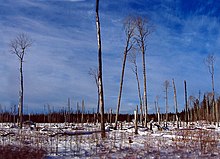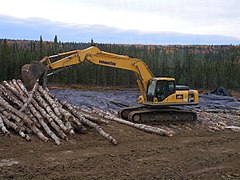Muskeg
This articleneeds additional citations forverification.(June 2007) |

Muskeg(Ojibwe:mashkiig;Cree:maskīk;French:fondrière de mousse,lit.moss bog) is apeat-forming ecosystem found in several northern climates, most commonly inArcticandborealareas. Muskeg is approximately synonymous withbogorpeatland,and is a standard term in Western Canada and Alaska. The term became common in these areas because it is ofCreeorigin;maskek(ᒪᐢᑫᐠ) meaning "low-lying marsh".[1]
Muskeg consists of non-living organic material in various states ofdecomposition(aspeat), ranging from fairly intact sphagnummoss,to sedge peat, to highly decomposedhumus.Pieces ofwoodcan make up five to fifteen percent of the peatsoil.Thewater tabletends to be near the surface. Thesphagnummoss forming it can hold fifteen to thirty times its own weight in water, which allows the spongy wet muskeg to also form on sloping ground.
Muskeg patches are ideal habitats forbeavers,pitcher plants,agaric mushroomsand a variety of other organisms.
Composition[edit]
Muskeg forms becausepermafrost,clayorbedrockprevents water drainage. The water from rain and snow collects, forming permanently waterlogged vegetation and stagnant pools. Muskeg is wet, acidic, and relatively infertile, which prevents large trees from growing, although stuntedshore pine,cottonwood,some species ofwillow,andblack spruceare typically found in these habitats.[2]It needs two conditions to develop: abundant rain and cool summers. A dead plant that falls on dry soil is normally attacked bybacteriaandfungiand quickly rots. If the same plant lands in water or on saturated soil, it decomposes differently. Less oxygen is available under water, so aerobic bacteria and fungi fail to colonize the submerged debris effectively. In addition, cool temperatures retard bacterial and fungal growth. This causes slow decomposition, and thus the plant debris gradually accumulates to formpeatand eventually muskeg. Depending on the underlyingtopographyof the land, muskeg can reach depths greater than 30 metres (100 ft).
Description[edit]
Although, at first glance, muskeg resembles aplaincovered with short grasses, a closer look reveals a bizarre and almost unearthly landscape. Small stands of stunted (often-dead) trees, which vaguely resemble naturalbonsai,grow where land protrudes above thewater table,with small pools of water (stained dark red) scattered about. Its grassland appearance invites the unwary to tread on it; however, even the most solid muskeg is spongy and waterlogged. Traveling through muskeg is a strange and dangerous experience, for the unaccustomed. Muskeg can grow atop bodies of water, especially small ponds and streams. Because of the water beneath, the muskeg surface sometimes moves and ripples underfoot. Thinner patches can collapse under significant weight, and cause larger animals to fall-through and become trapped underneath, drowning if an escape route is not found.Mooseare at a particular disadvantage, with their preferred diet of aquatic plants and grasses possibly drawing them dangerously near to muskeg; due to their long legs, minimal hoof area, and great weight, they are at great risk of falling and drowning. Hunters and hikers may occasionally encounter young moose in muskeg-covered ponds submerged up to their torsos or necks, having been unaware of the unstable ground.[citation needed]
Surface strength[edit]

Muskeg can be a significant impediment to transportation. During the 1870s, muskeg inNorthern Ontariowas reported to have swallowed a train and a thousand feet of track whole when a track was laid on muskeg.[3]
Many other instances have been reported of heavy construction equipment vanishing into muskeg in thespringas the frozen muskeg beneath the vehicle thawed. Construction in muskeg-laden areas sometimes requires the complete removal of the soil and filling with gravel. If the muskeg is not completely cleared to bedrock, its high water content will cause buckling and distortion from winter freezing, much likepermafrost.
One method of working atop muskeg is to place large logs on the ground, covered with a thick layer ofclayor other stable material. This is commonly called acorduroy road.To increase the effectiveness of the corduroy, preventerosion,[4]and allow removal of material with less disturbance to the muskeg, ageotextilefabric is sometimes placed down before the logs. However temporary winter access roads on muskeg (ice road), created by clearing the insulating snow and allowing the muskeg to freeze, are more commonly used as they are cheaper to construct and easier to decommission. Water is often sprayed on these roads to thicken the ice allowing heavy trucks and equipment to safely access remote sites in the winter.[citation needed]
In fiction[edit]
InJack London's short story, "Love of Life," the starving protagonist eats muskeg berries along the trail. "A muskeg berry is a bit of seed enclosed in a bit of water. In the mouth the water melts away and the seed chews sharp and bitter. The man knew there was no nourishment in the berries, but he chewed them patiently with a hope greater than knowledge and defying experience."
InMartha Ostenso's novelWild Geese,the land owned and beloved by the antagonist plays an important role: "Southeast, under the ridge, bottomless and foul, lay the muskeg, the sore to Caleb's eye. In the heat of summer it gave up sickly vapours in which clouds of mosquitoes rose. Cattle and horses, breaking through the pasture fence and heading for the hay field, had disappeared beneath its spongy surface." (p. 12)
InRick Riordan's novelThe Son of Neptune(in theHeroes of Olympusseries),Percy Jacksonsteps off a path nearSeward, Alaska,and falls through the muskeg. He would have drowned if another character,Hazel Levesque,had not jumped in after him.Frank Zhang,the third of their trio, pulled them out using his bow, with Hazel holding onto it and Percy holding onto her ankles.
Gallery[edit]
-
Stuntedshore pinegrowing on muskeg inWrangell, Alaska
-
Tracked excavator placing corduroy on muskeg nearRocky Mountain House,Alberta
-
CaterpillarD300E hauling on acorduroy roadbuilt over muskeg
Sources[edit]
- C. Michael Hogan. 2008.Black Spruce: Picea mariana,GlobalTwitcher.com, ed. Nicklas Stromberg, November, 2008
- "What on Earth is Muskeg?".Forest Facts.Tongass National Forest. 25 August 2000. Archived fromthe originalon 14 January 2012.
References[edit]
- ^Cree Dictionary."Maskek".Archivedfrom the original on 5 June 2009.Retrieved15 April2009.
- ^C. Michael Hogan. 2008
- ^"Building The Railroad Through The Canadian Shield".canadaehx.com.24 June 2021.Archivedfrom the original on 7 May 2024.Retrieved7 May2024.
- ^Government of Alberta: Geotechnical and Erosion ControlArchived21 December 2007 at theWayback Machine



